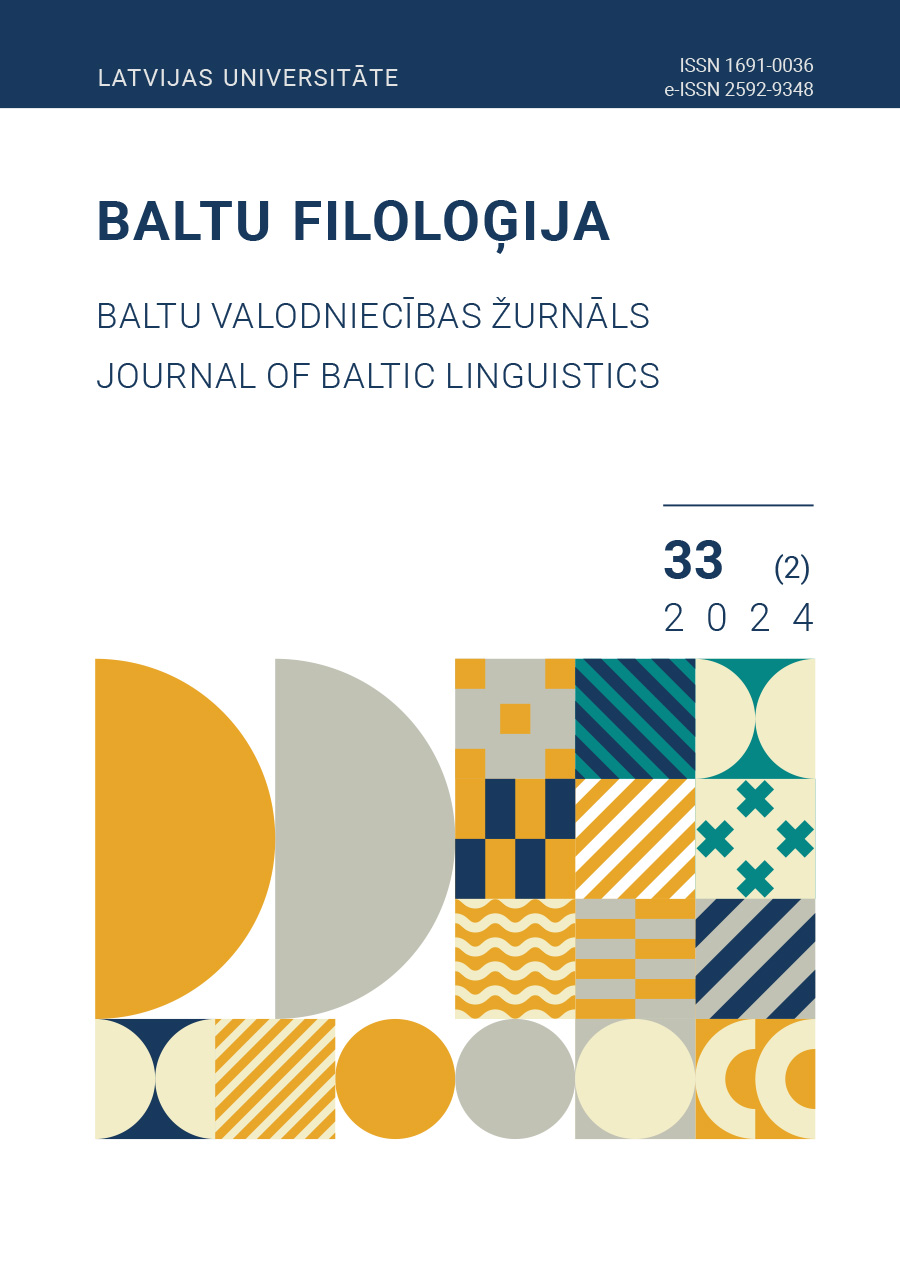On German and Latvian Names of Manor Estates in Latvia. Aspects of Translation
DOI:
https://doi.org/10.22364/bf.33.2.06Keywords:
17th–18th century toponyms, German language, Latvian language, translations, dictionariesAbstract
The article is dedicated to Latvian placenames in German and Latvian, and their reciprocal correspondences, with a special focus on the aspect of translation inspired by Jānis Endzelīns’s article “On German Names of Manor Estates in Latvia” (Endzelīns 1928). The study on names of ancient manor estates has also been topical from a contemporary perspective because they underlie the names of Latvian villages (often parish centres), and also some towns, to a large extent.
Earlier systematic and broader compilations of placenames in Latvian were included in four dictionaries from the 17th and 18th centuries (Mancelius 1638; Langius 1685; Lange 1773; Lange 1777; Stender 1789). The article analyses placenames of Kurzeme and Zemgale – altogether 155 pairs of placenames; however, all the mentioned dictionaries include only 15 of them: Aizpute, Auce, Dobele, Durbe, Emburga, Embūte, Jelgava, Kalna muiža (nowadays Tērvete), Kuldīga, Liepāja, Rundāle, Saldus, Sēlpils, Sesava and Valtaiķi. The number of placenames in the dictionaries varies considerably: Mancelius included 41 names, Langius – 21, Lange – 67, but Stender had included 140 placenames (see Table 1). Although it can be admitted that all subsequent authors had access to Mancelius’s dictionary, such placenames as Gramzda, Kalēti and Sece were included only in that dictionary. Placenames in Langius’s dictionary were taken from Mancelius’s dictionary. Only Grobiņa was added to them.
There are several models of placename derivation in Latvian and German. One model includes translating, and it accounts for 10-13% of all the placenames in the analysed sources (see Table 2). Altogether, 19 translations of placenames have been established (see Table 3). Translations comprise common words from both languages, and also a dialectal lexis represented in a smaller number and connected with the subdialect of a location; however, Middle Low German and Baltic German influenced German placenames and thus sometimes makes it impossible to separate them.
Four pairs of placenames did not fit into the overall analysis. Although they had features of translation, they did not comply with the category. The evaluation of the derivation of these placenames and reciprocal borrowing should be included in prospective research by identifying and analysing other relational models of Latvian and German placenames.
References
BHO = Feldmann, Hans, Heinz von zur Mühlen (Hrsg.). 1990. Baltisches historisches Ortslexikon, Teil 2, Lettland: (Südlivland und Kurland), Köln, Wien: Böhlau (=Quellen und Studien zur baltischen Geschichte, Bd. 8/II).
Deutsches Wörterbuch von Jacob Grimm und Wilhelm Grimm. Neubearbeitung (A-F), digitalisierte Fassung im Wörterbuchnetz des Trier Center for Digital Humanities, Version 01/23. Zugänglich: https://woerterbuchnetz.de/?sigle=DWB2&lemid=A00001
Dunsdorfs, Edgars. 1983. Muižas. Melburna: Kārļa Zariņa fonds.
Endzelīns, Jānis. 1928. Par Latvijas vāciskajiem muižu vārdiem. Filologu biedrības raksti VIII, 6–7.
Feldmann, Hans. 1938. Verzeichnis lettländischer Ortsnamen. Riga: E. Bruhns.
Gutzeit, Woldemar von. 1864. Wörterschatz der deutschen Sprache Livlands. Bd. 1. Riga: Kymmel.
Karulis, Konstantins. 1992. Latviešu etimoloģijas vārdnīca. 2 sējumi. Rīga: Avots.
Köbler, Gerhard. 2014. Mittelniederdeutsches Wörterbuch. Zugänglich: https://www.koeblergerhard.de/mndwbhin.html
Lange, Jacob. 1773. Lettisch Deutscher Theil des vollständiges Lettischen Lexici. Schloß Ober=Pahlen.
Lange, Jacob. 1777. Vollständiges deutschlettisches und lettischdeutsches Lexicon, nach den Hauptdialecten in Lief- und Curland aausgefertigt. Mitau: J. Fr. Steffenhagen.
Langius, Johann. 1685. Nīcas un Bārtas mācītāja Jāņa Langija 1685. gada latviski-vāciskā vārdnīca ar īsu latviešu gramatiku. Pēc manuskripta fotokōpijas izdevis un ar apcerējumu par Langija dzīvi, rakstību un valodu papildinājis E. Blese. Rīga: Latvijas Ūniversitāte, 1936.
Latviešu valodas dialektu atlants. Leksika. Kartes. Rīga: Zinātne, 1995
Laur, Wolfgang. 2001. Deutsche Orts-, Landes- und Gewässernamen in den baltischen Ländern. (Hamburger Beiträge zur Geschichte der Deutschen im europäischen Osten; 8). Lüneburg: Verl. Nordostdeutsches Kulturwerk.
Mancelius, Georg. 1638. Lettus, Das iʃt Wortbuch / Samt angehengtem täglichem Gebrauch der Lettiʃchen Sprache; Allen vnd jeden Außheimiʃchen / die in Churland / Semgallen vnd Lettiʃchem Liefflande bleiben / vnd ʃich redlich nehren wollen / zu Nutze verfertigt / Durch GEORGIVM MANCELIVM Semgall. der H. Schrifft Licentiatum &c. Riga: Gerhard Schröder.
Melnalksnis, Augusts (sast.). 1918. Dʃimtenes weetas: alfabetiʄkâ kahrtibâ ʄakahrtots Latwijas pilʄehtu, meeʃtu, draudʃchu, pagaʃtu, muiʃchu un t. t. ʄarakʃts: latweeʄchu-wahzu un wahzu-latweeʄchu walodâs. I. Widʃemes latweeʄchu daļa. Walmeera: Ꞩabeedribas “Seme” apgahdeens.
Stender, Gotthard Friedrich. 1789. Lettisches Lexikon In zween Theilen abgefasset, und den Liebhabern der lettischen Litteratur gewidmet. Mitau: Steffenhagen.
Zemzare, Daina 1961. Latviešu vārdnīcas (līdz 1900. gadam). Rīga: Latvijas PSR Zinātņu akadēmijas izdevniecība.
Downloads
Published
Issue
Section
License
Copyright (c) 2024 University of Latvia

This work is licensed under a Creative Commons Attribution-NonCommercial 4.0 International License.


